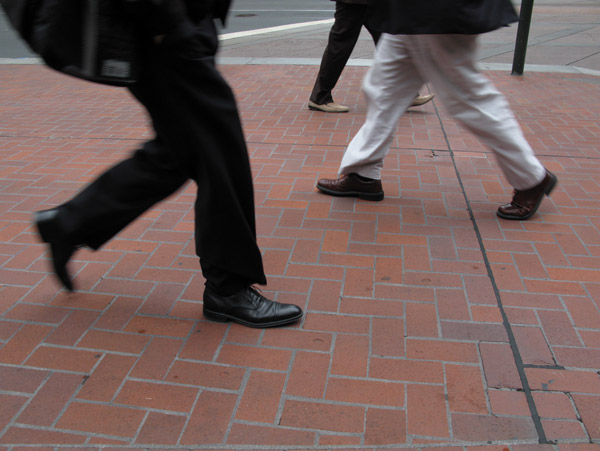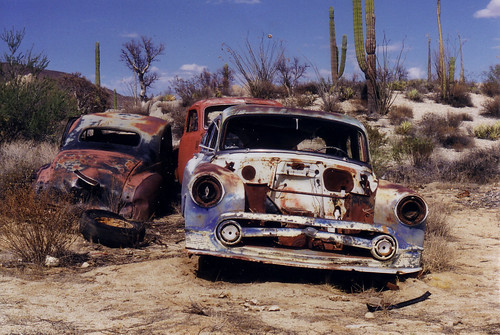Time to strap on your preferred footwear, turn off the intertubes, and give those rusty bones a fair shake. ‘Cause you know what they say on gravity-rich planet Earth: These boots are made for walking, but your sneakers, loafers, or bare feet will do.
To whet the pedestrian appetite and spur the mood for the boot, I’ve put together this multimedia stream* of 100% organic, homegrown walking gospel that should get even the most avid couch, desk, office and car potatoes out of their preferred mode of inertia:
Walking has been the main mode of transportation for humanity ever since evolution enabled bipedalism, our ability to move upright on our two rear limbs, also known as legs. While the invention of the wheel and the domestication of horses enhanced our mobility to cover longer distances, our legs have been the primary means of transportation for short-distance trips throughout history. Even today, about 40% of all trips made in the United States are two miles or less. So how did we get to a point where fewer than 10% of all trips are made by walking and biking?
To talk about walking in the context of such major issues as global warming, peak oil, pollution, or public health seems at first glance to be inane, if not outright cute. After all, for those of us fortunate enough to have fully functioning limbs, walking is as second nature as eating or sleeping, devoid of sexy technological wizardry or any other bold and news-worthy discoveries of planet-saving proportions. However, a closer look at this time-honored human means of transportation reveals how the diminished role of walking in industrialized societies stands in direct cause and effect relationship to the big environmental problems of our time.
Consider this: According to the BP Statistical Review of World Energy Americans consumed 6.5 BILLION barrels (884 million metric tons) of oil in 2008, or 22.5% of world oil consumption. While China burned 2.75 billion barrels (375 million metric tons) and increased its share to 9.6% of total world oil consumption, Americans are still by far the biggest consumers of oil per capita. Over 45% of crude oil, more than 10 million barrels every day, is refined into light distillates, the gasoline which powers our cars. Another 29%, almost 7 million barrels a day, is refined into middle distillates like jet kerosene and diesel oils. In other words, 75% of the oil we burn and release into the atmosphere (almost 5 billion barrels a year!) is used to haul ourselves all over the place with our asses firmly planted in a “sitting device.”
Aside from the high environmental costs of fueling an automobile — and rarely added into the equation — there is a whole catalog of waste and excess associated with modern driving habits. A study conducted by the respected German research institute Umwelt-und Prognose-Institut Heidelberg (also see Dirty from Cradle to Grave – John Whitelegg) provides a glimpse into the hidden costs (externalities) of ‘sitting in motion’:
The Environmental Cost of One Car
Extracting Raw Materials (steel, iron, rubber, plastics and aluminum):
26.5 tonnes of waste
922 cubic metres of polluted air
Transporting Raw Materials:
12 litres of crude oil in the ocean
425 million cubic metres of polluted airProducing the Car:
1.5 tonnes of waste
74 million cubic metres of polluted airDriving the Car:
18.4 kilos of abrasive waste
1,016 million cubic metres of polluted airDisposing of the Car:
(sulfuric acid for batteries; heavy metals and VOCs in paints; mercury in circuits; CFCs and other greenhouse gases used in foam seats and body parts; asbestos in brake pads)
102 million cubic metres of polluted airConclusion: A car causes more pollution before it’s ever driven than in its entire lifetime of driving.
Of course, this is only the car itself. If you think about the wide-ranging and far-reaching impact of chauffeuring ourselves around in 3000-4000 pounds of metal on a daily basis, additional questions abound:
1. How much energy does it take to have an infrastructure supportive of the automobile, like building and maintaining roads, parking garages, traffic lights and signs, etc?
2. What’s the price being paid by native people and their environment from oil extraction in regions like the Niger Delta or the Ecuadorian Amazon?
3. What are the medical, emotional and economic costs of thousands of traffic deaths and casualties each year?
4. What’s the effect on overall public health of a population that uses mostly extraneous, or “borrowed” energy to move about? Would the U.S. have the highest obesity statistics of any industrialized country if more than 26 percent of adults engaged in vigorous leisure-time physical activity three or more times per week? Would medical expenses due to obesity account for 9.1 percent of total U.S. medical expenditures if we led more active lifestyles (in addition to better diets)?
Which brings me to that old faithful of transportation modes, pedestrian locomotion, aka walking.
The average person takes about 2,000 steps per mile. If you’re in a city, this translates to roughly 10 city blocks (in my neighborhood, 215 steps cover one block), or 15-20 minutes on foot. Thus, a two-mile round trip to the grocery store or the post-office takes about 30-40 minutes. As mentioned at the top, 40% of all trips taken in the U.S. are 2 miles or less, and almost 90% of those trips are made by car. Imagine the impact if all or most of these trips were done on foot or by bike!
Then there are the obvious health benefits of walking. According to the CDC, risk of death from heart disease could by reduced by 34 percent by walking at least 2 hours per week. A Duke University Medical Center study shows that even without any dietary changes, a brisk 30-minute walk 6 days a week is enough to trim waistlines and cut the risk of metabolic syndrome — an increasingly common condition that is linked to obesity and a sedentary lifestyle. What’s more, there are 49 more amazing health benefits to walking!
More important than all the numbers and statistics are some of the more intangible effects of walking on our culture, lifestyles and public spaces. When we walk, we connect directly with our environment, its sights, sounds, and scents. Whether you’re in an urban area or in nature, to walk is to see and hear what goes on in the spaces between, in the microcosms that are the foundation of life. Walking is a literal pathway into our community and the tapestry that connects us with one another, providing the direct human contact that is necessary to build deeper relationships, with everyone from friends and neighbors to our local merchants and people yet unknown. To walk is to talk . . . to one another.
In a world that’s been made unsustainable by our collective addiction to all things speedy, walking can be an act of healing, for the only way to slow down the hamster wheel is to slow ourselves down first.
o~O~o~O~o~O~o~O~o~O~o~O~o~O~o~O~o~O~o
*PS: Thanks to my musical family Chemystry Set, my awesome and ridiculously talented photographing partner Debra Baida, and my dear friend Tony Idarola’s (RIP) binaural sound effects, I was able to pull this one off without any stock additives.
.
Resources
http://www.americawalks.org
http://www.walkscore.com
http://www.carfreecity.us
http://www.worldcarfree.net
http://sundaystreetssf.com
http://ecocitybuilders.org
http://www.curseoftheblackgoldbook.com
http://chevrontoxico.com
http://tubercreations.com
50 Benefits of Walking DailyStudies
National Household Travel Survey
BP Statistical Review of World Energy 2009
CDC – Trends in Walking for Transportation in the United States, 1995 and 2001
National Bicycling and Walking Study by Federal Highway Administration
CDC – Climate Change Prevention
EPA – Smart Growth









This is well written. I’ve been a strong supporter of the feet and legs for a while now and like what you’ve put together. I would like to paraphrase some of this post on my own blog if thats ok? http://www.iaminformed.wordpress.com I would just like to post the fact that you’ve put together this great bit on the costs of the car and the benefits of walking.
Tyler, by all means, feel free to spread this as far and wide as you see fit. Btw, I love your blog, I’ll add it to my blog roll. Thanks for your great work, let’s keep in touch!
Thanks!
[…] For more on the social benefits of walking and more stats and numbers: http://svenworld.wordpress.com/2009/08/11/talking-the-walk […]
Sven, this is beautiful. A great piece of art with a great message. You walk… I mean ROCK!
hehe, thanks Patty, couldn’t have done it without you 😉
[…] garanterer Sven, som laget denne filmen, at den er 100% […]
[…] garanterer Sven, som laget denne filmen, at den er 100% økologisk! […]
[…] Mer om bakgrunnen til filmen kan du lese om her. […]
[…] Sven’s accompanying essay, Walking the Talk. Share this:TwitterFacebookLike this:LikeBe the first to like this […]